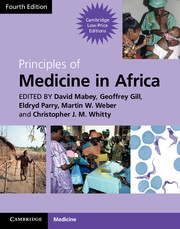Book contents
- Frontmatter
- Contents
- Contributors
- Foreword
- Section 1 Health and disease
- Section 2 Mother and child health
- Section 3 Infection: general principles
- Section 4 Major common infections
- Section 5 Bacterial infections
- 22 Typhoid, paratyphoid and non-typhoid Salmonella infections
- 23 Streptococcus pyogenes and Staphylococcus aureus
- 24 Rickettsial infections
- 25 Brucellosis
- 26 Leptospirosis
- 27 Relapsing fever
- 28 Plague
- 29 Anthrax
- 30 Tetanus
- 31 Diphtheria
- 32 Leprosy
- 33 Cholera
- Section 6 Viral Infections
- Section 7 Protozoal infections
- Section 8 Helminth infections
- Section 9 Fungal infections
- Section 10 Non-communicable diseases
- Section 11 Diseases of body systems
- Section 12 Cancer and Palliative Care
- Section 13 Venoms and Poisons
- Index
- References
29 - Anthrax
from Section 5 - Bacterial infections
Published online by Cambridge University Press: 05 March 2013
- Frontmatter
- Contents
- Contributors
- Foreword
- Section 1 Health and disease
- Section 2 Mother and child health
- Section 3 Infection: general principles
- Section 4 Major common infections
- Section 5 Bacterial infections
- 22 Typhoid, paratyphoid and non-typhoid Salmonella infections
- 23 Streptococcus pyogenes and Staphylococcus aureus
- 24 Rickettsial infections
- 25 Brucellosis
- 26 Leptospirosis
- 27 Relapsing fever
- 28 Plague
- 29 Anthrax
- 30 Tetanus
- 31 Diphtheria
- 32 Leprosy
- 33 Cholera
- Section 6 Viral Infections
- Section 7 Protozoal infections
- Section 8 Helminth infections
- Section 9 Fungal infections
- Section 10 Non-communicable diseases
- Section 11 Diseases of body systems
- Section 12 Cancer and Palliative Care
- Section 13 Venoms and Poisons
- Index
- References
Summary
Anthrax is a widespread zoonosis transmitted from animals (mainly herbivores) to humans. Robert Koch discovered the transmission cycle at the end of the nineteenth century. Since then, anthrax has been successfully controlled in Europe and the USA, though interest in Bacillus anthracis has recently risen due to the danger of terrorist attacks using B. anthracis. Most cases in Africa are due to contact with infected animals, animal products or infested soil.
The problem in Africa
Anthrax is a common infection of animals, both domestic and wild, and sporadic outbreaks of human anthrax are reported in many parts of Africa. Clinicians practising especially in rural areas of Africa need to have a basic knowledge of the epidemiology and clinical picture of anthrax. Outbreaks have been reported from Zambia, Zimbabwe (Davies, 1982), Tanzania, Kenya and South Africa (WHO, 1994), Ghana (Opare et al., 2000), Burkina Faso (Coulibaly and Yameogo, 2000) and Guinea Bissau (De Ridders, 1994). In The Gambia, human anthrax is endemic, occurring every dry season in a specific region (Heyworth et al., 1975).
The organism
Anthrax is caused by Bacillus anthracis, a Gram-positive encapsulated, non-motile, aerobic bacterium that forms spores, which can survive in dry ground for many years and infect animals and humans (Turnbull, 1999; Spencer, 2003).
- Type
- Chapter
- Information
- Principles of Medicine in Africa , pp. 341 - 344Publisher: Cambridge University PressPrint publication year: 2013



